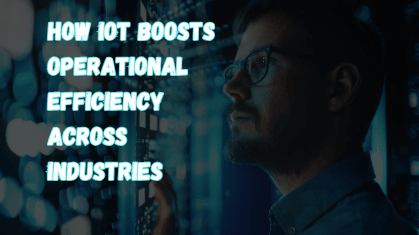
The Internet of Things (IoT) is changing how businesses work by making them more efficient, reducing costs, and increasing productivity.
The Internet of Things (IoT) is changing how businesses work by making them more efficient, reducing costs, and increasing productivity. IoT connects devices, machines, and systems so they can share data and make smarter decisions. From manufacturing to healthcare, industries across the USA are using IoT to optimize their processes and stay ahead of the competition. Let’s see how IoT is improving efficiency in different industries.
IoT is a network of connected devices that communicate and share data through the internet. These devices include sensors, smart machines, and wearable technology. IoT helps businesses automate tasks, monitor performance, and make better decisions.
Key Benefits of IoT:
Collects and analyzes real-time data
Automates repetitive tasks
Manages resources more effectively
Improves customer experience
Manufacturing is a leading industry using IoT to improve efficiency. Smart sensors and connected machines provide real-time data, helping manufacturers optimize production.
How IoT Helps Manufacturing:
Predictive maintenance prevents breakdowns by spotting issues early.
Automated systems reduce downtime and increase productivity.
Real-time monitoring tracks inventory and reduces waste.
Example: A factory with IoT sensors can detect machine problems before they cause delays, saving time and repair costs.
IoT is making healthcare operations smoother and more effective. Smart devices and wearable technology improve patient care and simplify administrative work.
How IoT Helps Healthcare:
Wearable devices monitor patient health and provide updates to doctors.
IoT systems organize patient records and reduce paperwork.
Smart inventory systems keep medical supplies available.
Example: Hospitals using IoT devices can monitor patient vitals remotely, leading to faster responses and better care.
Retailers use IoT to manage inventory and improve the shopping experience for customers.
How IoT Benefits Retail:
Smart shelves track inventory and notify staff when restocking is needed.
Connected devices create personalized shopping experiences.
Automated checkouts make payments faster.
Example: A store with IoT-enabled shelves can monitor product availability in real time, ensuring customers find what they need.
IoT helps farmers grow crops more efficiently and manage resources better. Smart sensors and connected devices provide useful data.
How IoT Helps Farmers:
Soil sensors guide irrigation by monitoring moisture levels.
Weather sensors give accurate forecasts for planting and harvesting.
Drones with IoT technology check crop health from above.
Example: Farmers using IoT sensors can save water and ensure crops get the right amount of hydration.
IoT is helping transportation and logistics companies improve delivery times and cut costs. Connected vehicles and tracking systems make supply chains more efficient.
How IoT Improves Transportation:
GPS trackers show real-time vehicle locations.
IoT systems optimize delivery routes, saving fuel and time.
Sensors monitor vehicle health and prevent breakdowns.
Example: Logistics companies using IoT-enabled GPS can reroute drivers to avoid traffic, ensuring faster deliveries.
While IoT has many benefits, businesses face challenges when implementing it:
Cost: Setting up IoT devices and infrastructure can be expensive.
Security: Connected devices can be targets for cyberattacks without proper security.
Data Management: Handling large amounts of data requires advanced tools.
Despite these challenges, IoT’s advantages usually outweigh the difficulties, especially with careful planning and support.
The future of IoT is promising. Advances in artificial intelligence (AI) and 5G technology will make IoT even more powerful. Businesses can expect greater automation and efficiency.
What’s Next for IoT:
AI Integration: IoT devices combined with AI will make smarter decisions.
5G Networks: Faster connections will improve IoT performance.
Sustainability: IoT will help create eco-friendly solutions.
IoT is changing how industries work by improving efficiency, cutting costs, and increasing productivity. Whether in manufacturing, healthcare, retail, agriculture, or transportation, IoT helps businesses achieve their goals. As technology advances, IoT’s potential will grow, making it a key part of modern business strategies.
For more insights on how technology can transform your business, visit CreativeWebNexus.
© 2024 Crivva - Business Promotion. All rights reserved.